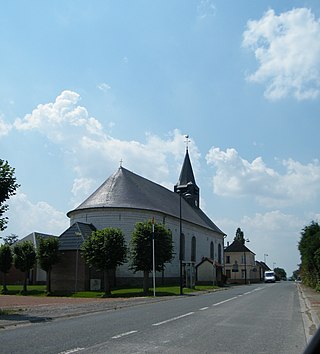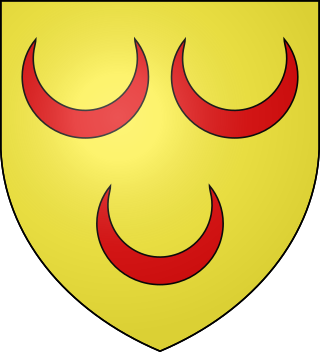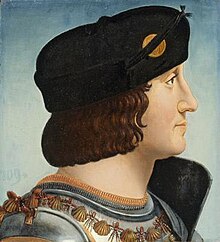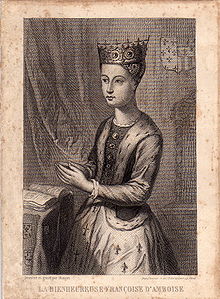
Charlotte of France was the second child and second daughter of King Francis I and his wife Claude.
Anselm de Guibours was a French Discalced Augustinian friar and noted genealogist.

Philip of Orléans was a Duke of Orléans, Touraine, and Count of Valois, the fifth son of King Philip VI of France and his wife Joan the Lame.

Philippe de Bourbon, Duke of Vendôme (1655–1727) was the grand prior of France in the Order of Malta. Vendôme held senior military positions throughout his life, in various command roles.
Charlotte of Naples, also known as Charlotte of Aragon and Princess of Taranto, was the eldest daughter and eventual heiress of King Frederick of Naples. Although her father was dispossessed of his kingdom, her descendants, the House of La Trémoïlle maintained their dynastic claim in exile.
Anne de Laval, Princess of Taranto, was a French noblewoman and nominal pretender to the Kingdom of Naples. She was born at Vitré, Ille-et-Vilaine, the daughter of Guy XVI de Laval, count of Laval, and of Charlotte of Aragon, Princess of Taranto.
Leroi, Le Roi or Roi is a French given name and surname of Norman origin. It is a variant spelling of Leroy, meaning "The King". Its Old French source roi, roy, gave rise to this name and variations during the Middle Ages.

Varennes is a commune in the Somme department in Hauts-de-France in northern France.

Isabella of France and Burgundy was the daughter of Philip V of France and Joan II, Countess of Burgundy.
Marie Anne d'Orléans, petite-fille de France was a French Princess and youngest daughter of Gaston d'Orléans. She held the rank of Grand daughter of France. She was a member of the House of Orléans.

Louis-Léon de Brancas, 3rd duc de Lauraguais, 6th duc de Villars, was a French general and author, and a member of the French Academy of Sciences.

Louis-Armand-Constantin de Rohan, Chevalier de Rohan and Prince de Montbazon, was a French naval officer of the eighteenth century.

The House of Lannoy is the name of an old and important Belgian noble family that takes its name from the town of Lannoy in northern France. The name comes from l'Annoy, which means 'the alderwood' in Picard French of Flanders.
Alan III de Rohan, was the son of Alan II, Viscount of Rohan. He was the 3rd Viscount of Rohan and Lord of Corlay.

Alan IV de Rohan, called the Young, was the eldest son of Alan III, Viscount of Rohan and Constance of Penthièvre. He was 4th Viscount of Rohan and Lord of Corlay. He took part to the Third Crusade.
Jean Baptiste de Durfort, duc de Duras was a French nobleman as duc de Duras and was created a Marshal of France while also having the additional rank of a Peer of France.

Gérard of Ham, Lord of Ham, was the son of Eudes I, Lord of Ham. He was the first Lord of Ham to use the armorial attested to his House.
Eudes II of Ham, Lord of Ham, was the eldest son of Lancelin of Ham, brother of Eudes' predecessor, Gérard, Lord of Ham.
Robert of France, was the youngest child of King Philip IV of France and Joan I of Navarre. He died young, but was briefly betrothed to Constance of Sicily.
Alexandre de La Rochefoucauld, 5th Duke of La Rochefoucauld Due his children being daughters his dukedom was inherited by his cousin Louis Alexandre de La Rochefoucauld due to salic law













